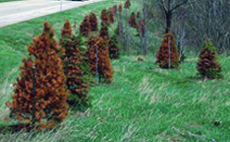Salt
July 31, 2015
De-icing salt (sodium chloride) can injure trees in several ways: direct contact of sodium chloride on the foliage from splashing and spray mist, and high levels of salt in the soil. High sodium levels in a plant can interfere with a number of metabolic processes including photosynthesis and protein synthesis. In areas with acute doses of de-icing salts, such as parking lots and sidewalks, plants may suffer osmotic stress, similar to ‘fertilizer burn.’

Severely salt-injured white pines along an expressway. Deciduous trees with chronic salt injury often develop extensive witches’ brooms due to branch dieback.
Management
De-icing salts such as calcium chloride and calcium magnesium acetate (CMA) are more expensive than sodium chloride but much less damaging to plants. Protect susceptible plantings in high traffic areas with a screen of burlap-covered snowfence. Sodium is easily displaced from cation exchange sites in the soil. Applying gypsum or lime will supply other cations and speed the movement of sodium out of the soil. In salt prone areas, plant salt tolerant species and avoid salt sensitive species. For a list of salt tolerant trees see The Urban Horticulture Institute website.
Print a PDF of this page: Abiotic injury - salt



 Print
Print Email
Email



